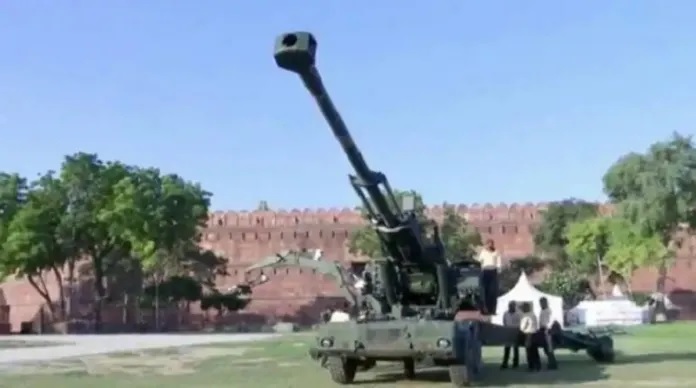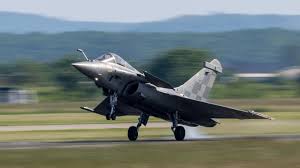Made in India cannon will salute on August 15, range of 48 km, accurate fire in minus 30 to 75 degree temperature

On the morning of August 15, as soon as the Prime Minister hoists the tricolor at the Red Fort, the national anthem will start playing. It will start with a 21-gun salute. A total of 21 gun salutes will be given during the national anthem of 52 seconds.
For the last 74 years, this work is done by firing 21 special shells from 7 guns made in Britain. The shells are special because these balls are blank, that is, they will only explode. The name of these guns is 25 pounder gun. Meaning, a cannon that can fire 25 pounds, or about 11.5 kg.
This time this 74 years old picture will have changed. For the first time, with these 25-pounder British guns, the echo of the country-made ATAGS i.e. Advanced Towed Artillery Gun System will also be heard.
In this explainer, let us know what is this ATAGS, what is its specialty and why is it discussed so much?
Question: What is ATAGS i.e. Advanced Towed Artillery Gun System?
Answer: As its name suggests Advanced Towed Artillery Gun System, it is a towed gun that is pulled from a truck. However, after firing it, it can go some distance on its own like Bofors. That means shoot and run. The caliber of this gun is 155 mm. This means that 155 mm shells can be fired from this modern cannon.
ATAGS is also called howitzer. Howitzers are small guns. Now you will think that how such a big cannon can be called small. In fact, very large and heavy guns were used in the war until the Second World War and beyond. It was very difficult to carry them over long distances and deploy them at high altitudes. In such a situation, lighter and smaller cannons were made, which were called howitzers.
Question: Who has made ATAGS, why is it being called indigenous Bofors?
Answer: This gun has been developed by Bharat Forge Limited, Mahindra Defense Naval System, Tata Power Strategic and Ordnance Factory Board by Armament Research and Development Establishment (ARDE), Pune-based lab of Indian Defense Research and Organization (DRDO).
Its development work started in 2013 and the first successful test was done on 14 July 2016.
The use and specialty of this cannon is very similar to Bofors cannon, hence it is also being called native Bofors.
Question: What are the specialties of this gun?
Answer: As we told you above that 155 mm shells can be fired from this cannon. Along with this, the range of bullets fired from this cannon is 48 km, while the Bofors cannon can fire the same shell up to 32 km away. It is capable of firing the highest distance in the world in the category of 155 mm. This cannon can fire accurately at a temperature of -30 °C to 75 °C.
Its 26.44 ft long barrel can fire 5 shells every minute. It also has a self-loading system like an automatic rifle. That is, the system of loading its shells is automatic. Thermal sight system has been installed to target with this cannon. This means that it can be targeted even at night. There is a feature of wireless communication.
Question: Where was this gun tested?
Answer: The first successful test of 155/52 caliber ATAGS took place on 14 July 2016. After this, in September 2020, in the user trial of the cannon, four workers were injured when the barrel exploded. After testing in November 2020, user trials were allowed again. The ATAGS cannon was successfully test fired in June 2021 at an altitude of 15,000 feet (4,600 m). ATAGS was trialled for a week at the Pokhran Field Firing Range from 26 April 2022 to 3 May.
The initial service guarantee requirements were re-verified during the trial. To prove the reliability of the guns, a 2 second firing was conducted successfully. During this the emphasis was on accuracy and consistency. Explosions and intense time series were taken care of during the test. This was followed by Electromagnetic Interference / Electromagnetic Compatibility (EMI / EMC) and Director General Quality Assurance (DGQA) tests.
Question: Army had reduced the weight of ATAGS, why?
Answer: In August 2018, the Defense Acquisition Council had approved the purchase of 150 ATAGS guns at an estimated cost of Rs 3,365 crore. The army needed 1,580 artillery guns in this category. The army objected to the issue of overweight in comparison with its requirements. The army wanted the ATAGS to weigh around 18 tons, so that it could be carried in the mountains. This was worked out later and the demand of the army was met.
The ATAGS cannon is capable of providing the shortest minimum distance at high angles and excellent performance in desert and mountainous terrain, apart from automatic mode firing and wireless communication. The ATAGS is designed to fire all types of ammunition with an all-electronic drive and a fully automatic ammo handling system.
Question: Why is this cannon included in the 21-gun salute given on Independence Day?
Answer: The government wants to promote Make in India. That is why she wants to bring this achievement in front of the whole world. For this, the army has been practicing for two weeks at the Red Fort.
Earlier this cannon was displayed on the Rajpath in the parade of 26 January 2017. Cadets from 14 countries are also coming to the Independence Day program at the Red Fort. These include Mauritius, Argentina, Seychelles, UAE, Muzambique, Fiji, USA, UK, Indonesia, Maldives, Nigeria, Brazil, Uzbekistan and Kyrgyzstan.
Question: Where and how did this tradition of giving gun salutes start?
Answer: On January 26, 1950, Dr. Rajendra Prasad was sworn in as the first President of India. After this he was given a 31-gun salute. Only then did the 21-gun salute become the international norm. After 1971, the 21-gun salute became the highest honor bestowed on our President and visiting Heads of State. The first 21 gun salute in India was given during the funeral of Mahatma Gandhi.
Till then the rules of funeral with state honor had not been made. In India, when someone is given a state honor, a 21-gun salute is also given.
Apart from Republic Day in India, guns are used on Independence Day on 15 August, Army Day on 15 January, Martyrs’ Day on 30 January and to welcome the heads of other countries at Rashtrapati Bhavan.
Question: Who completes the salute process?
Answer: A 21-gun salute is given by the Special Regiment of the Army. The traditional regiment is headquartered in Meerut and consists of about 122 jawans. However, this is not a permanent regiment. As soon as this regiment is shifted somewhere else, it is replaced by another regiment.
Question: Is the bullet fired from the cannon real?
Answer: The bullet fired from this cannon is made of a special type. This is called special ceremonial cartridge. It is blank. There is only smoke and sound in it. It does no harm.
The 21-gun salute to be held on the Independence Day will also see the 25 pound British guns inducted in the Indian Army since 1940, which are being used as ceremonial batteries since decommissioned in 1992. This is the first time that this gun will salute in conjunction with the modern ATAGS.







